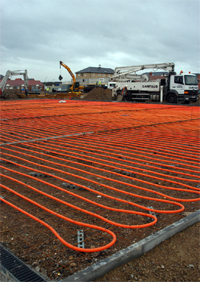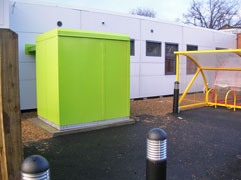RHI options – How to take advantage of the Renewable Heat Incentive
by Edward Thompson
The government has confirmed that RHIs will be paid from 28 November 2011 to those who install Renewable Heat in non-domestic buildings to save carbon emissions.
RHI subsidies are being provided because the nation needs to reduce carbon emissions and will pay you to invest in Renewable Heat for each kW/hour you need.
This is good news.
What forms of Renewable Heat are available?
Which form of Renewable Heat will suit your building?
The RHI subsidy is being provided because none of the standard forms of Renewable Heat is deemed to be economic on its own.
One of the most promising forms of Renewable Heat is solar thermal which lets you heat a lot of hot water to a high temperature. However, this is at its most efficient in summer when you probably don’t need much hot water.
Another promising technology is to use heat pumps which can extract energy from the ground to heat your building in winter. However, the catch here is that as heat is extracted from the ground, the ground gets colder and the heat pump becomes less efficient.
Wouldn’t it be good if you could combine these two technologies and use summer heat to warm your house in winter?
Interseasonal Heat Transfer is an integrated technology which does just that. IHT captures surplus heat in summer, stores it in ThermalBanks in the ground, to allow a heat pump to extract that heat more efficiently in winter.
The simplicity of this technique is startling, although the practical application has taken many years of research from ICAX Ltd to achieve the levels of efficiency now available. IHT can double the performance of an "unassisted" ground source heat pump. How is this breakthrough possible?
Breakthrough in Ground Source Heat Pump Performance
The key reason to use a ground source heat pump is – we are often told – that for one kilowatt of electricity the pump will yield four kilowatts of heat. In other words, a ground source heat pump can give you a Coefficient of Performance (CoP) of 4.
This is the good news and an attractive “Rule of Thumb”. The reality is that a GSHP will only give a CoP of 4 in favourable conditions. What are the assumptions?
Assume an efficient distribution system
One key assumption is that you are using an efficient heat distribution in your building such as underfloor heating. With the large surface used for underfloor heating it can be effective to circulate warm water at only at 40°C, instead of the need to circulate hot water at 75°C which is needed if you plan to distribute the heat with wall mounted radiators. If you adjust your GSHP to output water at 75°C the CoP will fall to a level of only 2.
At a CoP of 2 a GSHP is barely economic and the electricity it consumes will generate as much CO2 at the generating station as you would produce on site if you were to burn carbon fuels there. Therefore the output temperature is important.
Assume a ground temperature of 10°C
The input temperature from the ground is also important. The second key assumption is that the GSHP receives an input temperature from the ground of around 10°C. This is likely to be a valid assumption in autumn as the temperature of the ground at depth in the UK is likely to be close to 10°C. We are often told that the ground temperature is a constant 10°C. This is another “Rule of Thumb”.
It is surprising that at a depth of six metres the ground temperature is very close to 10°C everywhere in the UK (except where this is measured at higher altitudes when lower temperatures are found).
It is more surprising that the temperature measured at six metres depth on a midsummer day is the same as the temperature measured at night in midwinter. The reason for this thermal inertia is that heat only moves very slowly though the ground.
What happens next?
So what happens when a GSHP extracts heat from a slinky pipe in the ground? The temperature of the ground beside the pipe falls. So, it is not true to suggest that the temperature of the ground remains constant if you extract heat from that ground. The reality is that (surprise, surprise) the ground temperature falls as the GSHP extracts heat – and it takes time for heat in the surrounding ground to migrate toward the place heat was extracted from.
This manifests itself as a problem for "unassisted" GSHP installations as the amount of work required of the heat pump increases as the temperature of the ground falls – and the CoP also falls from the autumn level of 4 to a lower level.
Seasonal CoP – SPF – SEER
The amount by which the CoP falls over the heating season depends on the overall design of the heat pump installation, including the volume of ground from which the heat is being extracted. The key measure is not the CoP at any one moment, but the average CoP over the heating season. This is referred to as the “Seasonal Cop” (SCoP), the “Seasonal Performance Factor” (SPF) or the “Seasonal Energy Efficiency Ratio” (SEER). In practice the Seasonal CoP usually falls below 3 and often falls as low as 2.5. This is a weakness in many standard "unassisted" GSHP installations.
ICAX has been examining the heat properties of the ground for ten years using computer modelling and computational fluid dynamics to understand the characteristics of heat transfer in the ground.
Corollary
ICAX has analysed these issues and come up with a novel solution called Interseasonal Heat Transfer. The issue with an “unassisted” GSHP is that the performance falls over the heating season because heat only moves very slowly in the ground. The corollary of this is that if heat only moves very slowly in the ground the answer is to use the ground as a thermal bank by transferring heat into the ground in the summer (when solar heat is abundant) in order that it can be extracted more easily, and more cheaply, in winter.

Interseasonal Heat Transfer™
ICAX collects heat in summer from Asphalt Solar Collectors, stores the heat in ThermalBanks™ in the ground and releases it to provide space heating in winter using ground source heat pumps.
ICAX conducted a full trial of IHT for the Highways Agency at Toddington which was independently monitored and recorded by the Transport Research Laboratory. TRL produced a 118 page report on the findings which are published at Independent report on IHT by Transport Research Laboratories.
IHT is able to increase the ThermalBank temperature from the natural ground temperature of 10°C up to level over 25°C in the summer months. The consequence is that an ICAX heat pump only has to raise the ground temp by 15°C (from 25°C to 40°C) to deliver underfloor heating in contrast to an “unassisted” GSHP which has to raise the ground temp by 30°C (from 10°C to 40°C). The GSHP in an IHT installation has half as much work to do and, for this reason, can achieve an autumn CoP of 8, instead of 4.
The CoP of an IHT installation falls over the winter to an average seasonal CoP of 5.4, for the same reasons that an unassisted GSHP installation falls from around 4 to around 2.6 - the ground gets colder as heat is extracted from it.

Practical Renewable Energy – Ground Source Heating
The ICAX approach transforms the efficiency and economics of running a ground source heat pump and becomes the clear favourite for those who plan to exceed The Merton Rule requirement of at least 10% on site renewable energy – by a large margin.
For these reasons the London Borough of Merton has chosen Interseasonal Heat Transfer for its exciting new Intergenerational Centre.
See also: Independent report on IHT by Transport Research Laboratories



